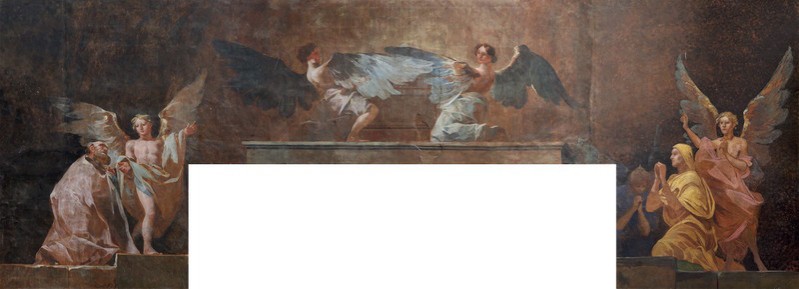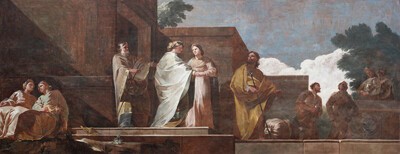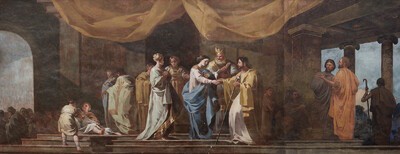- Cronología
- Ca. 1774
- Ubicación
- Church of the Monastery of Aula Dei, Zaragoza, Spain
- Dimensiones
- 306 x 844 cm
- Técnica y soporte
- Oil on plaster
- Reconocimiento de la autoría de Goya
- Documented work
- Titular
- Instituto Chemin Neuf
- Ficha: realización/revisión
- 07 Oct 2010 / 13 Jun 2023
- Otros títulos:
-
Saint Joachim and Saint Anne with Angels (San Joaquín y Santa Ana, con ángeles)
Construction began on the Church of the Monastery of Aula Dei in 1564, although it was not finished until well into the 17th century. The building was then redecorated in the baroque style in the second half of the 18th century. Goya was commissioned to paint a series of eleven large-scale murals in landscape format dedicated to the Life of the Virgin and distributed over the walls of the nave and transept.
The Book of Common Expenses of the Monastery (Libro de gastos comunes de la Cartuja) filed in the Aula Dei archives records the costs of gilding the frames of the paintings in 1774 and 1775.
The Disentailment caused the Monastery of Aula Dei to be abandoned from 1836 onwards, and led to the total loss of the paintings located in the south side of the church. These were repainted during the early 20th century by Paul and Amedée Buffet following the recovery of the monastery by the Order of Carthusian monks in 1901. The Parisian painters also retouched the seven remaining paintings by Goya to a varying degree. Until then no-one had realized that these were original works by Goya that should be preserved.
The seven paintings related to the Virgin Mary that have been preserved (albeit only partially) are as follows: Saint Joachim and Saint Anne with Angels (San Joaquín y Santa Ana con ángeles), Birth of the Virgin Mary (El nacimiento de la Virgen María), Marriage of the Virgin (Los desposorios de la Virgen), Visitation (La visitación), Circumcision of Christ (La circuncisión), Epiphany (La epifanía) and Presentation in the Temple (La presentación en el Templo). The cycle was distributed over alternate walls of the nave starting with the wall at the far end of the church, meaning that in order to follow the story viewers had to advance towards the transept looking alternately from right to left. All the panels have gilded frames which appear in the aforementioned documentation.
This is a wide-ranging, monumental cycle with clear dramatic qualities and simple but carefully designed compositions in a wholly classical style. The figures, shown life-sized in erect poses with serious expressions and wearing vast robes, express a sense of solemnity and peace. The most vivid colours are reserved for the most important groups and scenes in order to give them emphasis. This is accentuated by the light that radiates from the holy characters or is directed towards them.
In general, the scenes are composed around a base of several steps, with schematic architectural backgrounds, in some cases in the open air. Some of the figures' physical features or clothing are repeated, as in the case of the Virgin and the Hebrew priest.
In his Italian Sketchbook (Cuaderno italiano) Goya sketched two landscape format drawings that are very similar to some of the scenes featured in the Aula Dei. Various notes recording payments received that are recorded in this sketchbook for the year 1774 confirm that Goya worked in the Monastery of Aula Dei, as did his brother Tomás who was a gilder.
José de Vargas Ponce, whose portrait Goya painted visited the Aula Dei in June 1800, sending some notes to Ceán Bermúdez on the visit in which he comments: "In the church there are eleven oblong paintings representing the mysteries of Our Lady painted by Mr. Francisco Goya. The designs are preserved in the chapterhouse." Therefore, we know that there were some preparatory drawings or sketches which the Carthusian monks kept in the chapterhouse, although their whereabouts are today unknown. In 1832 the proctor of the monastery, Tomás López, recorded some traditional accounts related to Goya (Noticias tradicionales de D. F. Goya) which were collected by the Count of Viñaza, in which he claims: "In the years 1772 to 1774 in the church of the Monastery of Aula Dei Goya painted the life of the Virgin in various paintings."
The vastness of the space to be painted (the largest of all the compositions that Goya produced in his career), as well as some stylistic elements that seem to indicate developments in the painter's style from one scene to the next, have led some academics to conclude that these paintings were not produced in a single period of time; rather, they were painted in various phases during a period which - as a minimum - lasted from 1772 to 1774. According to Torralba, he may even have worked on the project until the 1780s. However, Goya's permanent move to Madrid in 1775 makes it very likely that he had completed the cycle by that time.
The first of the compositions is dedicated to the parents of the Virgin, Saint Joachim and Saint Anne, and is located on the wall at the far end of the church above and to the sides of the main door: the central section is shorter for this reason. This central part shows two angels with their wings unfolded kneeling before the Ark of the Covenant. On the left next to the door we can see Saint Joachim, also in a kneeling position and dressed in a vast, ochre-coloured cape. He is being led to the central scene by another angel wearing sandals and half covered by a blue tunic that exposes his torso. On the opposite side of the door, Saint Anne is depicted with another angel; however, this is not an original Goya, having been painted at a later date by the Buffet brothers.
The work was restored between 1978 and 1979 by Carlos Barboza and Teresa Grasa, and lately between 2010 and 2011.
-
Goya, su tiempo, su vida, sus obrasMadridTipografía de Manuel G. Hernández, Impresor de la Real Casa1887p. 462
-
Vie et ouvre de Francisco de GoyaParísOffice du livre1970pp. 39-41 (il.), cat. 42-48
-
BarcelonaPolígrafa1970vol. I, pp. 241-242
-
Las pinturas de Goya en la Cartuja de Nuestra Señora de Aula-DeiZaragozaMutua de Accidentes de Zaragoza1975
-
Sobre los documentos conservados en la cartuja de Aula DeiSeminario de Arte AragonésZaragoza1980pp. 119-122
-
Goya y Aragón. Familia, amistades y encargos artísticoscol. Col. Mariano de Pano y RuataZaragozaCaja de Ahorros de la Inmaculada de Aragón1995pp. 107-118 (il.)
-
Las pinturas murales de Goya en AragónMadridGobierno de Aragón y Electa España1996pp. 39-47
-
Las pinturas murales de Goya en la cartuja de Aula DeiFundación Goya en Aragón y Turner2008vol. II, pp.123-137
-
Goya antes del viaje a Madrid (1746-1774)BarcelonaGalaxia Gutenberg/Círculo de Lectores y Fundación Amigos del Museo del Prado2010pp. 315-336






